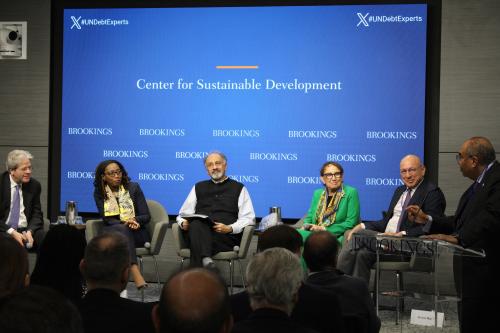The authors are members of the High-Level Advisory Group of the Scaling Community of Practice.
International development assistance is in crisis. The demise of USAID is the most dramatic manifestation of this crisis, but many traditional donor countries had already announced cutbacks in funding in recent years. The U.K.’s successive cuts in aid from its longstanding target of 0.7% of gross national income to 0.5% and most recently to 0.3% are part of this trend. According to the Organisation for Economic Co-operation and Development’s (OECD) Development Assistance Committee (DAC), international aid dropped by 7.1% in 2024. It will likely drop further in 2025 and possibly beyond.
Recent events remind us of the retrenchment in international development assistance in the early 1990s after the fall of the Berlin Wall. Those cuts shook up established views about aid, its architecture, and effectiveness and led to serious efforts to address longstanding concerns raised by aid critics. Now as then, we must grasp the opportunity to rethink the purpose of development assistance and improve its effectiveness, even as we struggle with the impacts of the current cutbacks.
Undoubtedly, the current situation is more dramatic than in the 1990s: shifts in geopolitical alignments, rising security threats, and the spread of populist political forces are now combined with severe fiscal constraints in most donor countries. These seismic shifts make it unlikely that the current cuts in foreign assistance will be reversed, giving rise to the notion that the peak of official development assistance was reached in 2023. But the pressing global development and climate challenges remain.
Now is the time, therefore, to take a hard look at international assistance to identify the most critical problems that it needs to tackle, address the shortcomings of old aid approaches, and offer a new paradigm for achieving global and national development and climate goals.
We are not alone in calling for a new approach to development assistance. Many others have done so and offered important ideas for reform of the global development finance system. Our focus is on ways to ensure that whatever development and climate finance can be mobilized in future is put to the best possible use in the pursuit of sustainable impact at scale.
We know from our own experience and from recently published research by the Scaling Community of Practice that the prevailing approach to international assistance prioritizes donor-driven, single-funder, standalone projects providing benefits for targeted populations rather than sustainable outcomes matching the scale of the problem or need. If large enough in size, these projects can have large-scale benefits, but because they are transactional in nature, they tend to be limited in time and scope and do not lead to sustainable outcomes over time at the national, regional, or global scale.
By contrast, the approach we call “transformational scaling” targets the problem or need at the scale at which it exists. Transformational scaling involves building scale into the design of projects and innovations; investing in systems strengthening to create the enabling conditions—policies, institutions, value chains, financing—that relieve constraints to scale and sustainability; and designing and funding longer-term pathways to transformational change.
The transformational scaling approach recognizes that donor-funded projects contribute to scalable and sustainable outcomes only to the extent they are based on locally owned systems and catalyze lasting institutional and policy change. Critically, it elevates the leadership role that national governments, regional entities, and the private sector must play in addressing the world’s most pressing global development and climate challenges. And it underlines the importance of country platforms and regional platforms. These are institutional frameworks designed to coordinate and align the priorities and initiatives of multiple funders working in partnership with each other and with the public and private stakeholders ultimately responsible for delivering goods and services at scale.
So while the recent funding cutbacks provide a sharp context, the more enduring challenge has been the lack of a sustainability and scalability lens in the design and funding of development programs. Over the years, donor-supported projects as well as national programs have often lacked long-term pathways. Therefore, the current crisis should be seen as a catalyst, not just for a new financing paradigm, but for a more deliberate focus on durability, scalability, and institutional ownership from the outset.
Fortunately, there are examples of countries, organizations, and programs that have successfully and sustainably addressed development and climate challenges at scale. Examples include de-worming solutions and vitamin A-enriched sweet potatoes in Africa, cash transfer programs in multiple countries (including the anti-poverty program Progresa-Oportunidades in Mexico), the National Health Mission and digital public infrastructure in India, and an array of Chinese government-supported development programs involving highly effective scaling practices.
And funder organizations are beginning to adapt their operational practices. The international Scaling Community of Practice—a network of 5,000 development and climate experts and practitioners from 70 countries, the majority from the Global South—has sponsored 25 case studies of international funder organizations interested in pursuing systematic scaling approaches, among them the International Fund for Agriculture and Development, the Global Financing Facility, Grand Challenges Canada, CARE, Catholic Relief Services, and the Systematic Observations Financing Facility. This study finds that these funder organizations are increasingly focusing on the scaling agenda. The World Bank’s International Finance Corporation has mainstreamed scaling using platform approaches, and the OECD’s DAC has just produced a guidance document on scaling.
The Scaling Community of Practice has distilled lessons of funders’ scaling experience into practical ways funder organizations can and need to support transformational scaling based on local leadership and institutional development. These include: build scaling into assistance from the beginning based on a clear vision of what sustainable impact at scale looks like; take a long-term view (10-15 years); create and leverage lasting partnerships, beginning with co-financing and country or sectoral platforms; and, above all, align costs and implementation requirements at scale with sustainable domestic financial and implementation institutions and resources.
The case studies of funder organizations also show that to mainstream scaling effectively into their operational practices, funders have to adapt their mission statements and results targets, their operational policies, managerial and staff capacity and incentives, and their monitoring and evaluation practices. Above all, they need to have a leadership that drives the mainstreaming process as a deep institutional change effort that is sustained over multiple years.
But it is not enough for some funders to change their operational practices. What is needed is for a critical mass of funder organizations to adopt coordinated approaches to transformational scaling. Only then will the international assistance architecture effectively support sustainable development and climate action at scale. Transformational scaling should be endorsed as an epochal shift in development cooperation practice at the fourth U.N. Financing for Development Conference in Seville at the end of June this year.
The Scaling Community is planning a five-year campaign (2026-2030) to mainstream scaling policies and practices throughout the development and climate community to turn the current crisis in development and climate assistance into a lasting paradigm shift to support country-owned and sustainable development outcomes at scale. We call to action all stakeholders—public, private, and civil society—to join this effort to translate the challenge into opportunity.
The Brookings Institution is committed to quality, independence, and impact.
We are supported by a diverse array of funders. In line with our values and policies, each Brookings publication represents the sole views of its author(s).



Commentary
From crisis to sustainable impact at scale: Rethinking global development
May 16, 2025